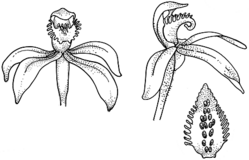Common name: Honey Caladenia
Caladenia testacea R.Br. APNI* Synonyms: Stegostyla testacea (R.Br.) D.L.Jones & M.A.Clem. APNI*

Description: Terrestrial herb.
Leaf narrow-linear to 5 cm long and 8 mm wide, and sparsely hairy.
Inflorescence to 18 cm high, rarely > 2-flowered, hairy. Sepals and lateral petals to 1 cm long, narrow, thick, the outer surfaces with dense, dark hairs, the inner surfaces white or pale green to greenish yellow becoming brown at the tips. Dorsal sepal forming a cap over the column. Labellum ± ovate, 6–8 mm long, obscurely 3-lobed, with a whitish base; lateral lobes reduced, margins toothed with stalked calli with yellow or purple heads. Central calli crowded into 4 rows bearing globose, granular heads, dark purple (basal calli sometimes with white heads); calli stalks becoming shorter towards midlobe tip until heads appear congested and sessile. Column with broad apical wings and pink stripes; basal glands absent.
Flowering: September–February
Distribution and occurrence: Grows in sclerophyll forest, woodland and heath, especially after light timber felling; from coastal sites to high altitudes; south from Newcastle district.
NSW subdivisions: NC, CC, SC, CT
Other Australian states: Vic. Tas.
Text by P. Bernhardt
Taxon concept: Flora of NSW 4 (1993)
APNI* Provides a link to the Australian Plant Name Index (hosted by the Australian National Botanic Gardens) for comprehensive bibliographic data
***The AVH map option provides a detailed interactive Australia wide distribution map drawn from collections held by all major Australian herbaria participating in the Australian Virtual Herbarium project.
|


